‘Book Mystique Review - Wegener Media G4/550mhz Upgrade For Pismo
Wednesday, October 24, 2007
by Charles W. Moore
The Pismo PowerBook, now closing in on eight years since its introduction at MacWorld Expo Tokyo in March, 2000, has enjoyed an exceptionally long useful service life thanks to its superb engineering, reasonably rugged construction, and the availability of G4 processor upgrades of up to 550 MHz. The Pismo is probably my favorite PowerBook model ever. I have two of them, both upgraded to 550 MHz G4, with SuperDrive DVD-burning expansion bay modules and larger capacity hard drives.
While the clock speed of these 550 MHz upgrades is not dramatically greater than the stock 400 MHz and 500 MHz Power PC 750 G3 processors that the Pismos shipped with, the modest boost is welcome and the real news is the G4’s Altivec vector engine and 1 MB of fast 250 MHz L2 caching, which combine to provide a nice performance boost, especially when using Altivec-optimized programs like Photoshop, plus support for applications that require a G4 as a minimum processing requirement.
Several vendors sell 550 MHz G4 Pismo processor upgrades, including Daystar, FastMac and Wegener Media, whose product is the subject of this review.
Wegeners’ Pismo upgrade is the least expensive one available at $199.00 + an $80.00 core deposit which will be refunded when you return your old processor card.
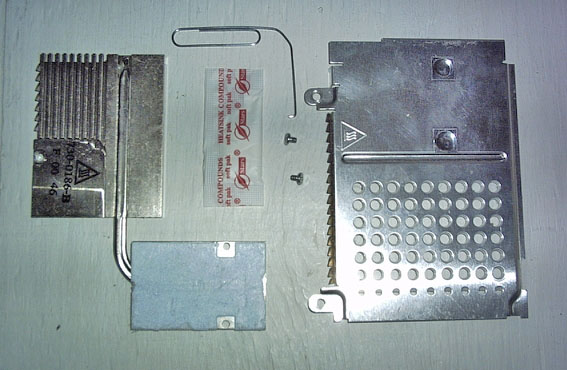
The Wegener Media Pismo G4 processor upgrade kit is a very complete, and includes a processor daughtercard with the G4 CPU, a processor heat sink, a modified EMI shield cover plate with a copper contact pad soldered on, a tube of thermal paste to ensure proper heat transfer between the CPU and the heat sink, and even a paper clip bent to use as a tool to extract the processor daughtercard from the motherboard, as well as a spare set of screws for the EMI shield, and a guide to help walk you through the installation process.
Pismos are delightfully easy to work on compared with metal PowerBooks and MacBook Pros, all iBooks, and the MacBook (with the exception of hard drive swaps in the latter, which are simple). Having had Pismos open many times before, it took me about five minutes to swap the new processor in, and get the Pismo back up and running again. it booted right up with no hassle or fuss.
Here are the tools you will need - a Torx T-8 screwdriver for removing the EMI shield, a small Philips screwdriver to remove the heatsink screws, and a bent paper clip (more on the paper clip below). All are supplied with the Wegener Media upgrade kit.
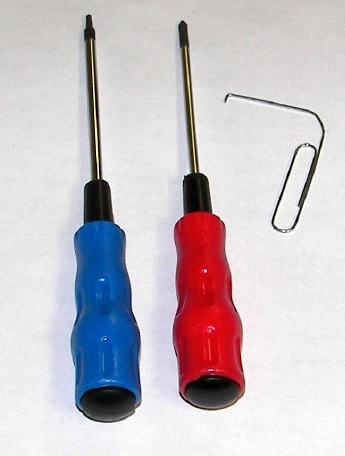
Shut the machine down, unplug the AC power adapter cable and pop the main battery from the left bay.
1. Pop the two latches at the back of the keyboard, and carefully flip the ‘board upside down to rest on the palm rest/trackpad area, making sure not to strain the delicate ribbon cable that connects the keyboard to the motherboard.
2. Remove the two Torx T-8 screws that fasten the EMI shield and lift it out.
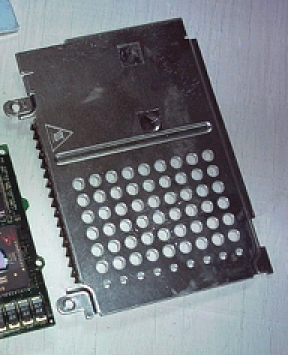
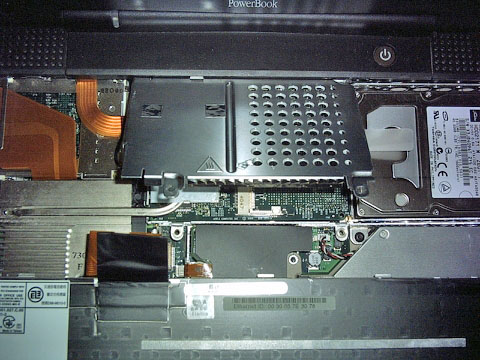
3. Next remove the long Phillips screw at the front of the heat sink module, and then the two short Phillips screws that fasten the heat sink to the top of the CPU. Carefully lift the heat sink assembly out and set it aside.
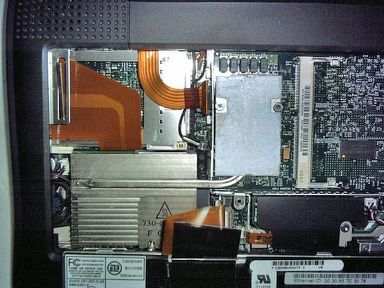
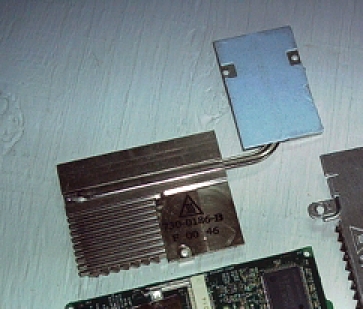
Note: technically, it would be proper practice to wear a wrist ground strap when working on computer internals to guard against static discharge. I have never bothered, and have not encountered any problems, but you never know. In lieu of grounding yourself externally, it’s prudent to attach some bare metal surface inside the computer before proceeding.
Popping the processor daughtercard is supposed to be facilitated by a handy plastic pull tab at the right hand near corner of the processor card (next to the hard drive). In practice, with older machines that have been upgraded, I’ve found that more often than not the pull tab will be missing, and so it was with this machine.
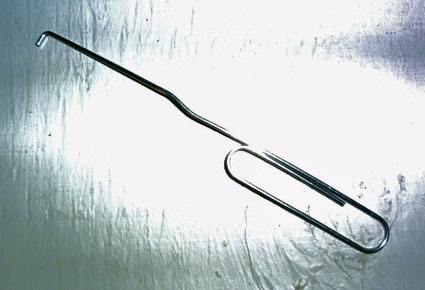
The workaround is to bend the end of a medium-sized paper clip at a right angle to create about a 3/16ths” step. As noted above, Wegener Media thoughtfully included a pre-bent paper clip with the upgrade kit. INsert the bent end of the paper clip through the convenient hole in the processor card’s main circuit board’s nearside right side corner, and pull upwards gently but firmly. The processor card should pop free of its plug-in connector on the motherboard without too much force. Carefully lift the processor card clear and rest it on a clean, non-static service.
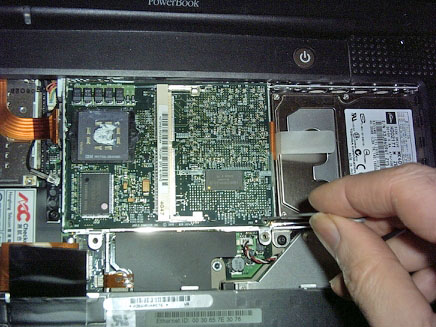
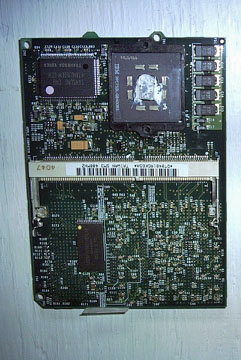
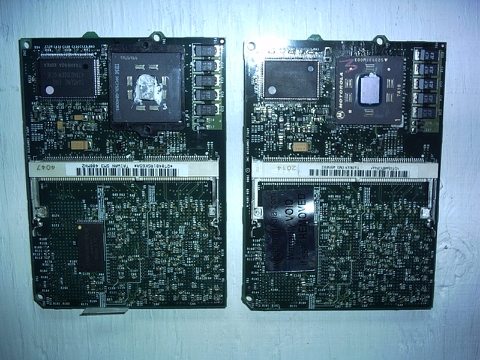
5. In most cases, you will need to remove the RAM modules from the lower and upper RAM expansion slots in the processor card and transfer them to the upgrade card. On this machine, there was a low profile 64 MB stick in the bottom slot, and a standard profile 512 MB stick in the upper slot. To remove the modules, pry the two plastic retaining clips at either end of the slot which allows the module to spring upward; then pull the module out of the slot. Installation is the reverse: insert the module in the RAM slot at an angle, and when it is seated properly, press downward until the retaining clips click home.
6. Once the RAM is installed, it’s time to install the processor card. Position it carefully in place and when it is lined up properly gently press down on the right hand end in way of the connector socket until the connector seats. Actually, I prefer to wait until the processor card is back in place before installing the upper RAM card, especially if it is a large one.
7. Now, before reinstalling the processor heat sink assembly, it is first necessary to coat the contact patch on the top of the CPU with a coating of the supplied thermal paste. Make sure to get a good, even coating of thermal paste on the contact surface, but don’t go overboard. All that is needed is a thin film between the contact surfaces, I used a small slot screwdriver to apply and spread the paste.
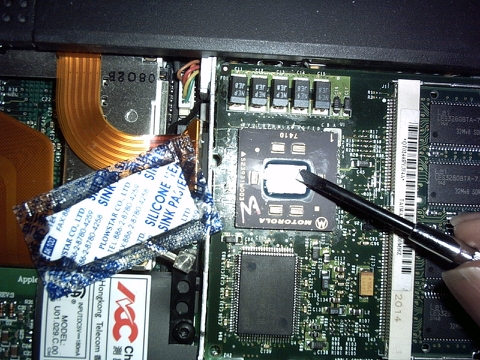
8. Clean away any materials such as old thermal grease from the contact surface of of the heat sink, position it on top of the processor, insert and insert and tighten long Philips head screws that inserts at the front of the assembly next to the palm rest. One oddity of the Wegener Media processor upgrade is that there is no bracket with screw holes to receive the two screws that fasten the heat sink contact pad to the top of the CPU unit, so you just leave those out on reassembly.
9. Replace the EMI shield and its two Torx T-8 screws. Sometimes it’s necessary to wiggle the shield a bit to get its back edge seated properly under the rear lip of the keyboard aperture. Flip the keyboard back into place and press down until the latches click home. You’re done!.
In production use for the past several days, the Wegener Media G4 Pismo upgrade is performing flawlessly. In terms of performance, I don’t perceive any substantial difference between it and Pismos running 550 MHz Daystar and FastMac processor upgrades, although the Wegener unit does seem to run a bit cooler than the FastMac unit. Wegeners say they use PPC7410LE version processors, which run cooler than competitive products using PPC 7400/500LE and regular 7410/533P chips. Whatever, the Pismo with the Wegener upgrade barely gets warm to touch even after several hours in use.
The difference in performance you will experience over a stock 400 MHz or 500 MHz G3 Pismo will depend somewhat on the sort of stuff you do with computers. The biggest advantage of the G4 processor is its support for Motorola’s Altivec “Velocity Engine” technology, but which requires software applications optimized for Altivec to take full advantage of. For example, I use Adobe Photoshop Elements a lot, and it’s Altivec optimized, as were most of the late PowerPC era Apple software applications and to some degree OS X itself. You really notice a difference with the G4 upgrade running those programs.
On the other hand, running non-Altivec optimized applications, the difference in going from 400 MHz or 500 MHz G3 to 550 MHz G4 will be more subtle, although the boost in clock speed is obviously to the good. Wegener Media claims that their upgrade gives you performance surpassing most Powerbook Titaniums, thanks to a 1MB L2 cache running at 250MHz, and with lower power consumption as well so you’ll see longer battery life and cooler running.
The install yourself version sells for $199 ($80 core return required to be refunded after your core is returned within 30 days). Alternatively, you can ship your Powerbook to Wegener Media and they will install the upgrade for $239 and return it to you.
For more information, visit:
http://www.wegenermedia.com/pg4550.htm
Note: Letters to PowerBook Mystique Mailbag may or may not be published at the editor's discretion. Correspondents' email addresses will NOT be published unless the correspondent specifically requests publication. Letters may be edited for length and/or context.
Opinions expressed in postings to PowerBook Mystique MailBag are owned by the respective correspondents and not necessarily shared or endorsed by the Editor and/or PowerBook Central management.
If you would prefer that your message not appear in PowerBook Mystique Mailbag, we would still like to hear from you. Just clearly mark your message "NOT FOR PUBLICATION," and it will not be published.
CM